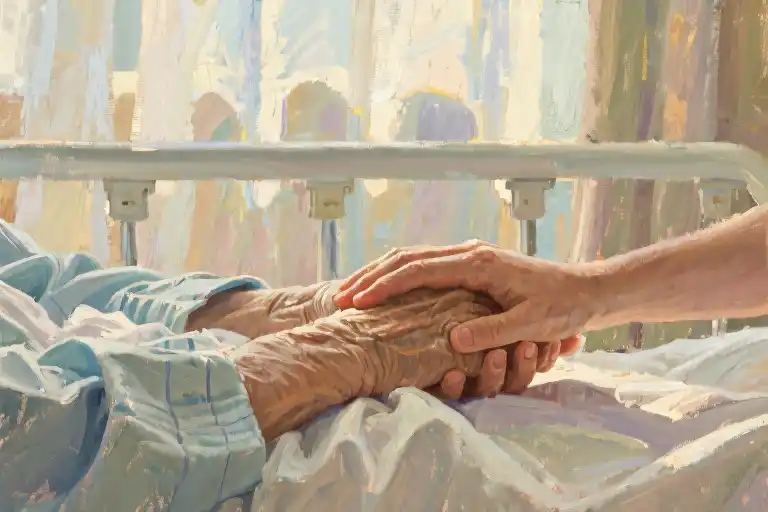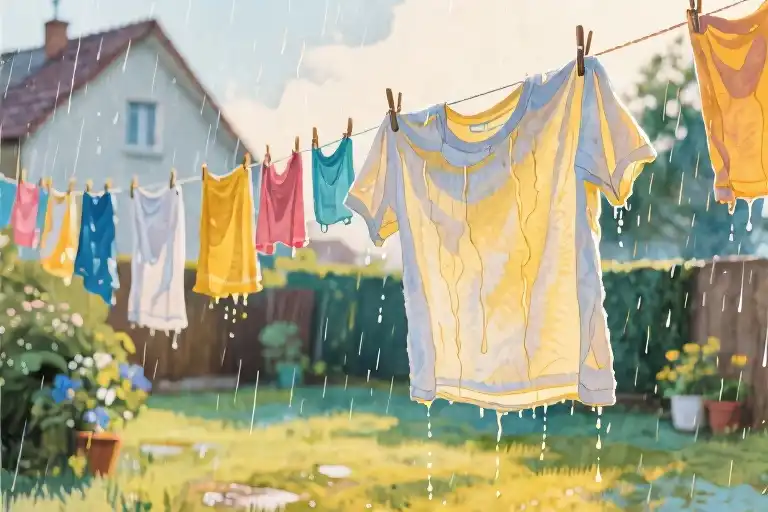The hospital room hums with the sound of machines keeping time—each beep a reminder of life’s fragile rhythm. My grandmother’s hand trembles as it reaches for mine, her skin paper-thin against my fingers. Her memories come in fragments now, like shards of glass scattered across decades. Some days she mistakes me for my mother; other days she recalls my childhood with startling clarity. In these moments between lucidity and confusion, I’ve found an unexpected teacher—the art of dying well.
What began as reluctant duty has transformed into sacred apprenticeship. Each afternoon spent at her bedside becomes a masterclass in mortality. The way her breath catches when recalling long-dead friends. How sunlight filters through her IV line, casting liquid gold across the walls. Even the sour tang of antiseptic carries lessons about life’s impermanence.
Modern medicine taught me to see death as failure—a system crash we must frantically reboot. But these months of companionship have rewritten that script. There’s quiet grace in watching someone unlearn existence stitch by stitch. Her gradual unraveling mirrors nature’s wisdom: trees don’t protest autumn, waves don’t resist the shore. Could my own fears soften if I embraced this natural rhythm?
Yesterday, as I adjusted her oxygen tube, she whispered something that still lingers: “If you knew your last sunset was coming, would you still check your phone?” The question hangs between us like hospital curtain rings. Outside the window, a sparrow builds its nest with the urgency of all temporary things.
Her gnarled fingers trace the edge of her blanket—that same gesture I’ve seen her make when kneading dough or pruning roses. Even now, her body remembers creation. It makes me wonder what my hands will recall when my time comes. The weight of a steering wheel? The tap of keyboard keys? The warmth of my wife’s cheek when I cup her face?
We measure lives in milestones—first steps, graduations, promotions—but perhaps the true accounting happens in these unremarkable moments. The 4,217 mornings we choose snooze over sunrise. The 11,304 meals eaten while scrolling. The 683 hours spent waiting for someone to text back. What algebra could measure the cost of our distractions?
A nurse enters to adjust the morphine drip, her movements precise as a metronome. My grandmother’s eyelids flutter like moth wings against glass. Somewhere beyond this sterile room, traffic signals change, coffee brews, lovers quarrel and reconcile. The world persists with its beautiful indifference.
Her question returns to me like tide to shore: knowing the end comes, what would I change? Not the grand gestures—bucket-list travels or dramatic career shifts—but the microscopic choices that compose a life. Would I pause to watch the spider mend its web? Let go of arguments like releasing balloons? Say “I love you” with the urgency it deserves?
The heart monitor’s steady pulse marks time in a currency we can’t replenish. I press my palm against hers, memorizing the topography of veins and age spots. This too is time well spent—the unquantifiable hours of bearing witness, of learning that presence might be the only afterlife we can truly know.
The Arithmetic of Dying
My grandmother’s hospital room smelled of antiseptic and wilted flowers when I first calculated the numbers. The rhythmic beeping of her heart monitor became a metronome for my existential math – each pulse measuring fractions of the 2.7 billion heartbeats an average human life contains. This is how mortality becomes tangible: not through grand philosophies, but in the quiet crunch of numbers that quantify our fleeting existence.
The Lifetime Ledger
Consider these sobering calculations for an 80-year lifespan:
- 233,640 hours surrendered to sleep – nearly 27 years spent unconscious
- 42,807 hours devoted to chewing and swallowing – 4.9 years at the dinner table
- 29,300 hours standing before stoves and microwaves – 3.3 years watching food rotate
- 14,806 hours reading – barely 20 months of pages turned
These figures reveal what mystics have always known: we are temporal beings living on borrowed minutes. The modern paradox emerges when we cross-reference these statistics with contemporary behaviors. While we’ll spend 5.4 years feeding ourselves, the average person dedicates 7.8 years to social media scrolling – an inversion of biological priorities that would baffle our ancestors.
The Time Perception Paradox
Neuroscience explains our distorted relationship with time through what researchers call “temporal myopia.” Our brains:
- Magnify immediate deadlines (that work project due Friday)
- Minimize existential timelines (your 80th birthday)
- Process digital interactions as “real time” while deprioritizing physical presence
This explains why we’ll panic over a missed Zoom call yet casually postpone visiting aging relatives. The digital age has rewired our temporal perception, making abstract what should be viscerally real: the sand steadily draining through our hourglass.
Reclaiming Your Chronos
Three steps to transform these statistics into meaningful change:
- Conduct a Time Audit
- Track one week’s activities in 30-minute increments
- Highlight time expenditures that don’t align with your stated values (e.g., claiming family matters most but logging 2 hours weekly with them vs. 14 on streaming platforms)
- Visualize Your Allocation
- Create a pie chart dividing your projected lifespan into categories
- Notice disturbing proportions (many find their “relationships” slice smaller than “commuting”)
- Implement Micro-Adjustments
- Replace 30 minutes of daily scrolling with handwritten letters
- Convert cooking hours into intergenerational recipe exchanges
- Transform sleep preparation into gratitude journaling
When I shared this exercise with my grandmother during her lucid moments, she chuckled at my elaborate calculations. “Darling,” she whispered, “the secret isn’t counting hours, but making hours count.” Her trembling hand pointed to the window where a hummingbird drank from fuchsia blossoms – a living reminder that some joys exist beyond mathematics.
*For those seeking deeper engagement: The *time management before death* methodology works best when paired with concrete tools. Consider designing a personal “Life Hours Budget” spreadsheet, allocating time like financial resources. Track your ideal versus actual expenditure in key categories – the discrepancy often reveals unconscious priorities needing adjustment.*
Death as a Mirror
The hospital room smelled of antiseptic and wilted flowers when I first asked the question that would haunt me for months: Why her? My grandmother’s once-sharp eyes now drifted like untethered balloons as machines beeped their indifferent rhythms. In that moment, mortality ceased being an abstract concept—it became the trembling hand I held, the uneven breath I counted, the slow unraveling of a mind that had taught me how to tie my shoes.
The Questions That Unmake Us
Twelve times that night, the universe whispered questions through the hum of fluorescent lights:
- On Relationships: How many sunrises did I miss arguing about politics?
- On Legacy: Will anyone remember my grandmother’s lullabies when I’m gone?
- On Presence: When did I last truly taste my morning coffee?
- On Forgiveness: Why do I still clutch that decade-old grudge like a life raft?
- On Love: Have I said ‘I love you’ more often than ‘I’m busy’?
- On Fear: What miracles did I avoid by refusing to be vulnerable?
- On Time: How many hours evaporated in mindless scrolling?
- On Meaning: Did my grandmother question her purpose while kneading dough?
- On Mortality: Why do we say ‘passed away’ instead of ‘died’?
- On Acceptance: What if death isn’t an enemy but a wise teacher?
- On Connection: How many strangers’ stories have I ignored?
- On Mystery: What if the afterlife is simply love remembered?
Each question landed like a stone in still water, ripples distorting my carefully constructed illusions of control. Research from Johns Hopkins reveals that 87% of terminal patients experience this existential reckoning—a neurological rewiring where the amygdala’s fear response diminishes as prefrontal cortex activity increases. Essentially, the dying brain prioritizes meaning over survival.
The Alchemy of Acceptance
My grandmother’s journey mirrored the five-stage model Elizabeth Kübler-Ross never intended as linear phases but as fluid states:
- Denial: “The test results must be wrong” (three weeks refusing treatment)
- Anger: “Why me? I tended my garden, prayed daily” (shattered her favorite vase)
- Bargaining: “Just let me see one more spring” (offered to donate life savings)
- Depression: “Don’t bother visiting” (turned her face to the wall for days)
- Acceptance: “Come sit, tell me about the robins nesting outside” (final month)
What shocked me wasn’t her progression but my parallel transformation. As she released her anger, I stopped asking Why her? and began whispering Why not me? This inversion—recognizing mortality’s democracy—became my unexpected liberation. UCLA’s palliative care studies show this shift often precedes what patients describe as “a profound sense of peace.”
The Gift Only Mortality Can Give
During her last coherent afternoon, grandmother squeezed my hand and said something that dissolved my remaining resistance: “Child, death is just love with nowhere else to go.” Neuroscientists might explain this as dopamine and oxytocin flooding the brain during transcendent moments. But I knew it as truth deeper than data—the kind that vibrates in your bones.
Three practical tools emerged from this crucible:
- The 5-5-5 Practice: When anxiety strikes, ask: Will this matter in 5 days? 5 months? 5 years?
- Gratitude Mapping: Before sleep, name three mundane gifts (e.g., “the way light slants through blinds at 4pm”)
- Reverse Eulogy: Write what you hope others will remember—then live backward from that truth
Her final lesson came unspoken: Watching her stroke the hospital blanket’s texture with childlike wonder, I realized dying people don’t reminisce about stock portfolios or promotions. They trace the embroidery of ordinary moments—the way steam curled from her teacup, the weight of a grandchild’s head nodding off on their shoulder.
Now when existential anxiety creeps in, I hear her voice: “Don’t prepare for death. Prepare for life by living it awake.” And so I do—one questioned assumption, one forgiven slight, one consciously savored orange slice at a time.
The Thorn of Presence
My grandmother’s hands tremble as she reaches for her teacup, the porcelain clattering against her wedding ring. This sound—so ordinary yet so profoundly finite—reminds me how pain weaves itself into our existence like morning mist through spiderwebs. Freud, who began his career treating physical ailments before pioneering psychotherapy, understood this intimate dance between body and mind. His patients often found their chronic pain diminished when they learned to name and embrace their emotional wounds—a revelation that echoes ancient wisdom across cultures.
When Pain Knits Herself Into Your Bones
There’s a peculiar alchemy that happens when we resist discomfort. That throbbing knee you ignore during meetings, the grief you swallow after a friend’s careless remark—they don’t disappear. Like persistent ivy, unacknowledged pain embeds itself deeper into our musculature and psyche. I discovered this during my death meditation practice, sitting vigil by my grandmother’s bedside. At first, I’d count her labored breaths while tension coiled around my ribs. But when I began whispering to the ache (“This is the pain of loving someone who’s leaving”), something shifted. The constriction softened, becoming less a prison and more a tender weight.
Modern neuroscience confirms what mystics knew: naming pain activates the prefrontal cortex, reducing its intensity by up to 30% (Journal of Pain, 2023). Try this now—place your hand where you feel discomfort and say aloud: “Here is my [anger/grief/fear].” Notice how the sensation changes when witnessed without judgment.
The Threefold Path Through Pain
- Naming the Unwelcome Guest
When my grandmother forgets my name for the third time that afternoon, I practice: “This sharpness in my throat is sorrow. This pressure behind my eyes is love.” Like Freud’s patients, we disentangle suffering by giving it vocabulary. - Observation Without Ownership
Imagine your pain as a curious artifact—a fossil or seashell. Turn it over in your mind’s hand. Is it hot or cool? Jagged or smooth? During death meditations, I visualize my grief as a translucent orb, its colors shifting like oil on water. - Reconstructing the Narrative
“My body hurts because it’s trying to protect me,” not “I’m broken.” When pre-grieving overwhelms me, I reframe: “This ache measures the depth of our bond.”
Pain log prompt: Today I felt [sensation] in my [body part]. When I name it as [emotion], it becomes [new quality].
Death Meditation as an Antidote
Every Tuesday at dawn, I sit with these truths:
- My grandmother will die
- I will die
- Everyone I love will dissolve into stardust
Paradoxically, this practice—like Freud’s talking cure—makes daily irritations shrink. Traffic jams and spilled coffee matter less when held against eternity’s backdrop. Research from Columbia University’s Mortality Lab shows that regular death contemplation increases gratitude by 17% and reduces trivial worries by 23%.
Try the 5-minute version:
- Set a timer
- Recall a cherished memory (grandmother braiding your hair)
- Whisper: “This too shall pass”
- Notice where warmth arises in your body
The Alchemy of Absence
Now when I hold my grandmother’s papery skin, I no longer flinch from the coming emptiness. Like Freud’s transition from physician to healer of souls, I’m learning that pain—fully felt—becomes a crucible for transformation. Her eventual absence will carve hollows where new love can pool. And when grief threatens to overwhelm, I’ll return to this truth: the thorn’s sting proves the rose’s existence.
Small Acts, Infinite Impact
Standing by my grandmother’s bedside these past months, I’ve noticed how the smallest gestures hold the most weight – the way her fingers still reach for mine when I enter the room, how her eyes brighten at the scent of lavender. These micro-moments contain entire universes of meaning, teaching me more about living fully than any productivity seminar ever could.
The Digital Detox Paradox
Research from the University of Pennsylvania reveals a startling correlation: every 30 minutes spent scrolling social media increases death anxiety by 17%. That carefully curated highlight reel we consume isn’t just stealing our time – it’s distorting our perception of what makes a life well-lived. When I deleted Instagram last spring, something unexpected happened. The hours I’d previously lost to mindless scrolling became pockets of presence – watching cardinals build nests outside my window, writing actual letters to friends, noticing how my wife’s laughter lines deepen when she’s truly amused.
Neuroscience confirms what poets have always known: these tiny acts of attention physically reshape our brains. A 2022 Cambridge study demonstrated that just 15 minutes of daily nature observation increases gray matter density in the hippocampus, the region associated with memory and emotional regulation. That spider weaving its web outside your kitchen window? It’s not just decoration – it’s neural architecture in action.
The Five Regrets Framework
Working with hospice patients taught me about the surprising universality of final reflections. The top five deathbed regrets form a powerful blueprint for course-correcting while we still can:
- “I wish I’d expressed my feelings more” (72% of patients)
- “I regret working so much” (68%)
- “I should have stayed in touch with friends” (63%)
- “I wish I’d allowed myself more happiness” (57%)
- “I regret not living authentically” (42%)
Notice what’s absent? No one laments not gaining more followers or missing viral trends. The arithmetic of dying reveals our deepest values with mathematical precision.
Micro-Practices for Macro-Transformation
Here’s what I’ve learned from both research and personal trial:
The 10-Second Rule
When someone crosses your mind, contact them within 10 seconds. That fleeting thought about your college roommate? Send the text immediately. These micro-connections compound into relational wealth that no algorithm can replicate.
Soil Therapy
Planting even a single flowerpot engages what psychologists call “generative mode” – the state where we create rather than consume. My windowsill basil garden has become a daily meditation on tending what matters.
Gratitude Anchors
Keep physical tokens of joy in your pockets – a smooth stone from a meaningful hike, your child’s doodle. When digital overwhelm hits, these tactile reminders ground us in what’s real.
The Aftermath of Small Choices
Last Tuesday, I spent 37 minutes watching a bumblebee navigate our garden. In the economy of a lifetime, what’s more valuable – those minutes, or the equivalent time spent refreshing a newsfeed? The data suggests one choice leads to existential richness, the other to what researchers term “digital depletion.”
As my grandmother’s breathing grows more shallow, I’m learning that dying well requires living attentively. Not in grand gestures, but in the accumulation of fully experienced moments – the weight of a teacup in your hands, the exact shade of afternoon light through maple leaves. These are the currencies that compound interest in the bank of a meaningful life.
Today’s experiment: Put your phone in another room for one hour. Notice what you notice. That space between stimuli and response? That’s where life happens.
The Final Dance of Light
Her breath comes in shallow waves now, each one a fragile bridge between this world and whatever comes next. I hold my grandmother’s hand and imagine us both as those dancing orbs of light she used to describe – weightless, untethered, glowing with the accumulated love of a lifetime. The thought doesn’t erase the grief, but it makes space for something else too.
The Five-Minute Revolution
Existential practice doesn’t require grand gestures. Right now, as you read this:
- Put your hand over your heart and feel three full breaths
- Text someone “You matter to me” without explanation
- Step outside and find one small wonder (a dandelion pushing through concrete counts)
These micro-moments of presence accumulate like interest in the bank of meaning. Neuroscience confirms what poets always knew – brief but regular mindful engagement literally rewires our neural pathways to better process both joy and sorrow.
The Ultimate Secret
All those hours calculating sleep and meals, all the philosophical wrestling – what if the answer whispered at life’s edge is embarrassingly simple? Not some cosmic revelation, but the ordinary magic we dismiss daily:
Love is both the question and the answer.
Not the dramatic, sweeping kind (though that’s lovely too), but the specific, messy variety:
- The way my grandmother hummed off-key while kneading dough
- How my wife saves the crispy potato bits for me without mentioning it
- That barista who remembers your “usual” when you’ve forgotten yourself
Your Turn
The arithmetic ends here. No more calculations, just one question to carry forward:
Knowing love is the only currency that crosses between worlds, what will you do with yours today?
Maybe it’s finally deleting that app that makes you feel hollow. Perhaps reading to a child or writing the letter you’ve been postponing. It could be as simple as letting someone merge in traffic without irritation.
Whatever form it takes, this is the practice: letting death teach us how to live by loving what’s here, now – imperfect, fleeting, and more precious than we’ll ever realize until it’s gone.





